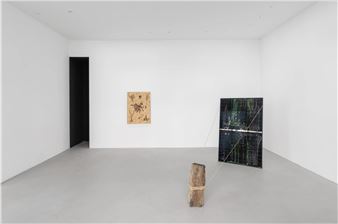Future Bodies from a Recent Past - Sculpture, Technology, and the Body since the 1950s
Contemporary art is characterized by an examination of the relationship between the body and technology. Many artworks from recent years reflect how we experience ourselves and our environments in the highly technological and networked present. Yet this relationship can be traced far back into the 20th century. The post-war period was marked by rapid technological change, which has become the pinnacle of ideological instrumentalization. It satisfied the need for novelty as much as the need to overcome the traumas of war. At the same time, technology became a crystallization point for global threats and fears of change, or even loss of control. Within this broad spectrum, ranging from euphoria about the future to critical distancing, sculpture also engaged with new technologies. These served equally as means of emancipation as surveillance and (external) control, and profoundly influenced our understanding of bodies.
Across two floors of the museum, ÔÇ£Future Bodies from a Recent PastÔÇØ presents for the first time a structured frame of reference for this narrative, ranging from the post-war period to the present. Throughout, it becomes clear that sculpture is particularly well suited to picking up and reflecting on these changesÔÇönot only because sculptures are physical objects in space and therefore provide a possibility for projecting our own corporeality, but also because they share their materials and production methods with the world that surrounds us. This permeability to outside influences is also evident in the works included here. The exhibition charts a journey through forms and modes of expression in sculpture, which have changed more in the last 70 years than probably ever before in its long history.
How has the relationship between humans and technology shifted since the 1950s? Can the boundaries still be clearly drawn? Where do our digital extensions, such as computers or cell phones, begin and end? What does this mean for our ideas of corporeality and materiality? And what are the social implications of these developments for our (collective) self-understanding? With these questions in mind, we invite you on a tour of the exhibition.

Recommended for you
Contemporary art is characterized by an examination of the relationship between the body and technology. Many artworks from recent years reflect how we experience ourselves and our environments in the highly technological and networked present. Yet this relationship can be traced far back into the 20th century. The post-war period was marked by rapid technological change, which has become the pinnacle of ideological instrumentalization. It satisfied the need for novelty as much as the need to overcome the traumas of war. At the same time, technology became a crystallization point for global threats and fears of change, or even loss of control. Within this broad spectrum, ranging from euphoria about the future to critical distancing, sculpture also engaged with new technologies. These served equally as means of emancipation as surveillance and (external) control, and profoundly influenced our understanding of bodies.
Across two floors of the museum, ÔÇ£Future Bodies from a Recent PastÔÇØ presents for the first time a structured frame of reference for this narrative, ranging from the post-war period to the present. Throughout, it becomes clear that sculpture is particularly well suited to picking up and reflecting on these changesÔÇönot only because sculptures are physical objects in space and therefore provide a possibility for projecting our own corporeality, but also because they share their materials and production methods with the world that surrounds us. This permeability to outside influences is also evident in the works included here. The exhibition charts a journey through forms and modes of expression in sculpture, which have changed more in the last 70 years than probably ever before in its long history.
How has the relationship between humans and technology shifted since the 1950s? Can the boundaries still be clearly drawn? Where do our digital extensions, such as computers or cell phones, begin and end? What does this mean for our ideas of corporeality and materiality? And what are the social implications of these developments for our (collective) self-understanding? With these questions in mind, we invite you on a tour of the exhibition.
Artists on show
- Akasegawa Genpei
- Aleksandra Domanovi─ç
- Alexandra Bircken
- Alina Szapocznikow
- Arthur Jafa
- Atsuko Tanaka
- Barbara Chase-Riboud
- Bruce Nauman
- Bruno Gironcoli
- Carol Rama
- Eduardo Paolozzi
- Edward Ihnatowicz
- Eva Hesse
- Felix González-Torres
- Franz West
- Friederike Pezold
- Germaine Richier
- Hannsjörg Voth
- Hans Salentin
- Hans Scheirl
- Jean Tinguely
- Jesse Darling
- Joachim Bandau
- John Chamberlain
- Judith Hopf
- Julia Phillips
- KAYA
- Kiki Kogelnik
- Kiyoji Ōtsuji
- Louise Bourgeois
- Lynn Hershman Leeson
- Mark Leckey
- Matthew Barney
- Mel Edwards
- Motoharu Jonouchi
- Nairy Baghramian
- Nam June Paik
- Nancy Grossman
- Nicola L
- Niki de Saint Phalle
- Paul Thek
- Pawel Althamer
- Rebecca Horn
- Robert Breer
- Robert Gober
- Sarah Lucas
- Senga Nengudi
- Seth Price
- Shigeko Kubota
- Shu Lea Cheang
- Stephanie Dinkins
- Tetsumi Kudo
- Tishan Hsu
- Tony Oursler
- Vassiliakis Takis
- Walter Pichler
- Yayoi Kusama
Contact details

Related articles
The exhibition ÔÇ£Future Bodies from a Recent PastÔÇöSculpture, Technology, and the Body since the 1950sÔÇØ at Museum Brandhorst brings to life a hitherto little-noticed phenomenon in art, and more particularly in sculpture: the reciprocal interpenetration of body and technology...
For the opening week of Various Others, here are five unmissable exhibitions to see this autumn.














